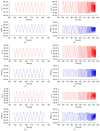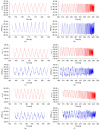An Experimental Study on Static and Dynamic Strain Sensitivity of Embeddable Smart Concrete Sensors Doped with Carbon Nanotubes for SHM of Large Structures
- PMID: 29522498
- PMCID: PMC5876626
- DOI: 10.3390/s18030831
An Experimental Study on Static and Dynamic Strain Sensitivity of Embeddable Smart Concrete Sensors Doped with Carbon Nanotubes for SHM of Large Structures
Abstract
The availability of new self-sensing cement-based strain sensors allows the development of dense sensor networks for Structural Health Monitoring (SHM) of reinforced concrete structures. These sensors are fabricated by doping cement-matrix mterials with conductive fillers, such as Multi Walled Carbon Nanotubes (MWCNTs), and can be embedded into structural elements made of reinforced concrete prior to casting. The strain sensing principle is based on the multifunctional composites outputting a measurable change in their electrical properties when subjected to a deformation. Previous work by the authors was devoted to material fabrication, modeling and applications in SHM. In this paper, we investigate the behavior of several sensors fabricated with and without aggregates and with different MWCNT contents. The strain sensitivity of the sensors, in terms of fractional change in electrical resistivity for unit strain, as well as their linearity are investigated through experimental testing under both quasi-static and sine-sweep dynamic uni-axial compressive loadings. Moreover, the responses of the sensors when subjected to destructive compressive tests are evaluated. Overall, the presented results contribute to improving the scientific knowledge on the behavior of smart concrete sensors and to furthering their understanding for SHM applications.
Keywords: carbon nanotubes; cement-based materials; self-sensing materials; smart concrete sensors; strain sensitivity; structural health monitoring.
Conflict of interest statement
The authors declare no conflict of interest.
Figures













References
-
- Dodds J.S., Meyers F.N., Loh K.J. Piezoelectric characterization of PVDF-TrFE thin films enhanced with ZnO nanoparticles. IEEE Sens. J. 2012;12:1889–1890. doi: 10.1109/JSEN.2011.2182043. - DOI
-
- Rathod V.T., Jain A. Ultrasonic guided wave sensitivity of piezopolymer films subjected to thermal exposure. ISSS J. Micro Smart Syst. 2018:1–10. doi: 10.1007/s41683-018-0019-1. - DOI
-
- Kavitha S., Daniel R.J., Sumangala K. High performance MEMS accelerometers for concrete SHM applications and comparison with COTS accelerometers. Mech. Syst. Signal. Process. 2016;66:410–424. doi: 10.1016/j.ymssp.2015.06.005. - DOI
-
- Zhou X., Xi L., Lee J. Reliability-centered predictive maintenance scheduling for a continuously monitored system subject to degradation. Reliab. Eng. Syst. Safety. 2007;92:530–534. doi: 10.1016/j.ress.2006.01.006. - DOI
LinkOut - more resources
Full Text Sources
Other Literature Sources

